 It often happens that the dataset you have is very detailed and hence very large. Displaying such volume of data in online mapping applications (eg. as KML on Google Map) is out of the question. The only alternative is to reduce the number of vertices to reduce the overall size of the file (ie. generalise the data). There is an excellent free online tool to do just that and surprisingly it works much better than commercial software that costs a fortune. It is called MapShaper.
It often happens that the dataset you have is very detailed and hence very large. Displaying such volume of data in online mapping applications (eg. as KML on Google Map) is out of the question. The only alternative is to reduce the number of vertices to reduce the overall size of the file (ie. generalise the data). There is an excellent free online tool to do just that and surprisingly it works much better than commercial software that costs a fortune. It is called MapShaper.It accepts spatial data in shapefile format only. It is an online service and you can upload files up to 80MB in size for processing. There are 3 generalisation algorithms to choose from. Activation of generalisation process itself is as simple as moving a slider “left to right” (from 0% reduction to 99%) – the result is visible on the screen instantaneously. Another great feature of the tool is that you can view original file underneath the generalised version to assess the quality of the process but also to pick the right generalisation level for your requirements.
Processed files can be downloaded back in either shp or EPS format (so it’s is also a great tool for straight conversion of files from shp format into EPS format, for use with vector graphics software!). There is simple edit functionality as well so you can add/delete vertices manually, if required. Generalisation process preserves topology so boundaries of adjoining polygons are generalised in an identical fashion – that is, they still “fit” perfectly. All in all, MapShaper is very straightforward to use.
File size still counts when performance of online mapping tool is the objective. For example, it will not be possible to display electoral boundaries as a single, full resolution file in Google Map application. But original 25MB shapefile can be reduced to just a few hundred KB using MapShaper tool, and then even further by converting shp to gzipped KMZ format. Here is an example of a Google Map application that uses both, full resolution data for close-ups and generalised version for whole of the country view: Australian elections map (work in progress!).
Related posts:
Free map service preview
Converting csv data into shapefile
Converting shapefile into KML
Colours for thematic mapping
Free GIS Tools – Google Map
Free Address Validation Tool
Manual geocoder for 70 countries








